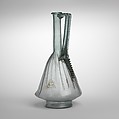Glass jug
Translucent blue green; handle in same color.
Solid rim, folded out, down, round, and in, with beveled upper surface forming sloping collar; tall, cylindrical neck, with slight horizontal indent at base; bell-shaped body with side flaring to hollow, slightly bulging flange, then tapering sharply in; hollow, outsplayed base ring; pushed-in bottom; strap handle with single central rib that has a long, downward notched trail that extends down side, applied to top of body, drawn up and outwards in a straight line, then turned in and down, and trailed off on top of neck and underside of rim.
On body, nineteen vertical ribs from flange to neck, and partially extending with a twist on to lower neck.
Intact, but internal cracks across bottom; pinprick and elongated bubbles in neck and handle; slight dulling, faint iridescence, and small patches of weathering.
This vessel belongs to a very distinctive group of attractive, tall-necked jugs that were probably made at Colonia Agrippina (modern Cologne) on the River Rhine in Germany. Examples have been found exclusively in the northwestern provinces of the Roman Empire. This jug is said to come from Samarobriva (modern Amiens, France).
Due to rights restrictions, this image cannot be enlarged, viewed at full screen, or downloaded.

